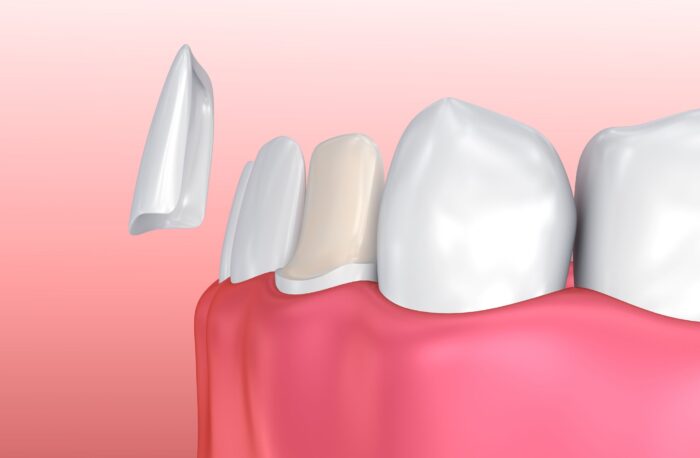Veneers and crowns both use porcelain covers or caps that placed on the teeth. They can both fix cosmetic issues, such as discolored, chipped, or crooked teeth. But a dental crown is much more involved and is more of a restorative practice, meaning it will fix broken, decayed, or weakened teeth. While they may seem similar, they both have different procedures and serve different purposes for your dental needs. It is important to know which is the right choice for you.

Cosmetic Dentistry with Porcelain Veneers
A veneer is a shell commonly made out of porcelain that is placed on the surface of your teeth. They will improve the aesthetic appearance of your teeth. They can treat chipped, discolored, or mismatched teeth. Veneers will permanently bond to your teeth.
The process of getting a veneer is simple and less invasive than getting a crown. Your dentist will begin by grinding down a small layer of the front of your tooth and then take a mold of your teeth in order to obtain a good fit for your veneers. Once your veneers are ready, your dentist will cement your veneer in place on your tooth.
Since the process involves grinding down part of your teeth, including the enamel, dentists consider this a permanent procedure. The enamel on your teeth protects your tooth from decay, and it cannot regrow once removed.
Veneers are still susceptible to breaking, chipping, and in some cases, falling out. Chewing ice or other hard foods or even chewing your fingernails may put your veneers at risk of breaking.
Veneers can still be affected by tooth decay, so dental care, such as regular flossing and dental check-ups, is necessary. While a dentist cannot repair veneers, these fixtures can last on average for 10 years and possibly up to 15 years with proper care and attention.
Restorative Treatment with Dental Crowns
While a veneer covers just the front of your tooth, a crown is a cap that covers the whole tooth. Dentists recommend this permanent treatment when injury or decay damages a tooth.
Like a veneer, it bonds into place with dental cement. A crown is required when dental fillings aren’t enough to fix a broken or significantly decayed tooth—or even teeth that have had their shape altered by teeth grinding.
The process of getting a crown is more involved than a veneer because it is a more involved procedure. Your dentist will take x-rays to assess the damage caused by infection or injury.
Then your dentist will file down the top and sides of your teeth in a cone-like shape. Depending on the type of crown, you may receive a temporary crown before you get your permanent crown at another dental visit.
You may also experience increased sensitivity to temperatures with a crown due to the enamel removal. Like a veneer, your crown is still susceptible to damage from hard foods or certain activities like grinding or clenching your teeth.
A crown doesn’t require any special care other than your regular oral health routine. Depending on the wear and care of your crown, they can last between 5-15 years.
Crowns and veneers can treat similar issues. But crowns can prevent further tooth decay or support a tooth with a large filling. Veneers must have enough healthy surfaces for their effective placement. You will need to talk to your dentist about your concerns before you make your choice between veneers or crowns.
